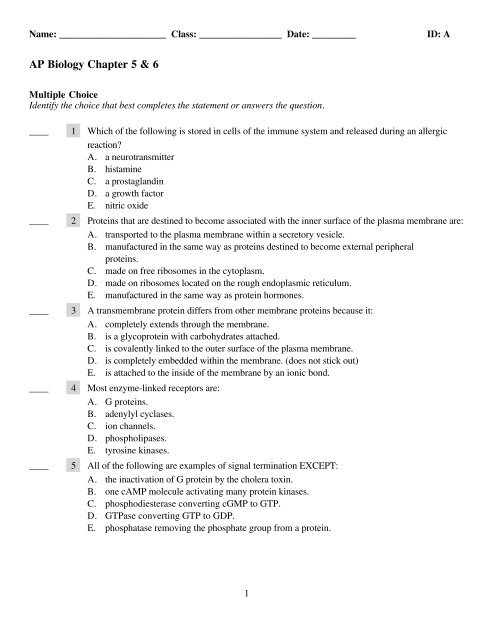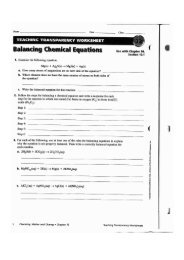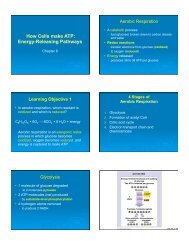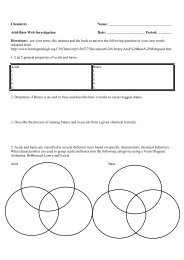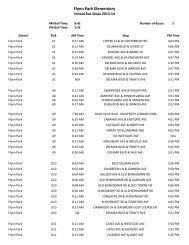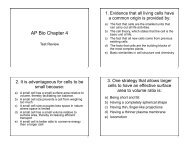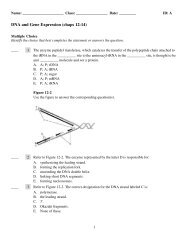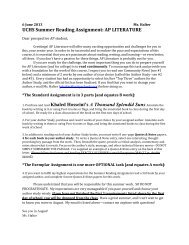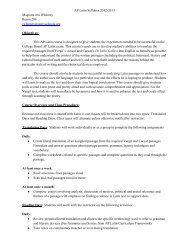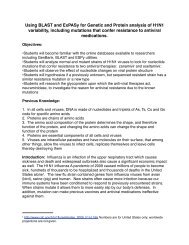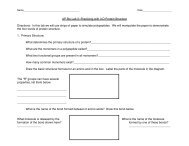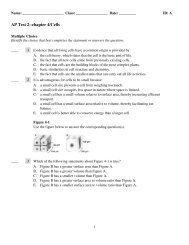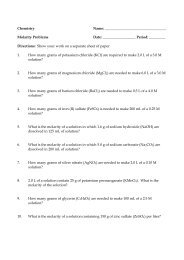AP Biology Chapter 5 & 6 - University City Schools
AP Biology Chapter 5 & 6 - University City Schools
AP Biology Chapter 5 & 6 - University City Schools
- No tags were found...
You also want an ePaper? Increase the reach of your titles
YUMPU automatically turns print PDFs into web optimized ePapers that Google loves.
Name: ______________________ID: A________________________18 Which of the following statements concerning intracellular receptors is FALSE?A. The ligand-receptor complex can inactivate genes.B. Some bind hydrophobic signaling molecules.C. The ligand-receptor complex can activate genes.D. Some function as transcription factors.E. They diffuse across the plasma membrane of target cells.19 In the phospholipase C signal transduction pathway, which are second messengers?A. phospholipase C and G proteinB. phospholipase C and protein kinase AC. cAMP and IP3D. PIP2 and IP3E. IP3 and DAG20 The passive movement of a substance along its concentration gradient is termed:A. osmosis.B. diffusion.C. dialysis.D. exocytosis.E. active transport.21 When a receptor binds to its G protein, which of the following happens next?A. The three G protein subunits come together.B. GDP is replaced by GTP.C. The G protein activates an enzyme.D. GTP is replaced by GDP.E. The signaling molecule binds to the receptor.22 Pinocytosis:A. is movement of molecules against the concentration gradient through a permeablemembrane.B. involves the specific binding of molecules to receptors on the cell surface.C. is the nonspecific uptake of fluids by pinching inward of the plasma membrane.D. is engulfment of large particles by the cell.E. occurs in protozoans and algae but not in more complex organisms.23 The higher the concentration of solute in a solution, the __________ the effective waterconcentration and the __________ the osmotic pressure.A. lower; higherB. higher; higherC. lower; lowerD. higher; lowerE. Answer cannot be determined from the information provided.4
Name: ______________________ID: A________________________24 Which of the following statements about the sodium-potassium pump is true?A. It transports 3 sodium ions out of the cell in exchange for 2 potassium ions.B. It transports 2 sodium ions out of the cell in exchange for 2 potassium ions.C. It transports water directly out of the cell.D. It transports hydrogen ions out of the cell.E. It transports 2 sodium ions out of the cell in exchange for 3 potassium ions.25 A protein kinase catalyzes the reaction in which:A. ATP is converted to cAMP.B. a protein loses a phosphate group.C. G protein is activated.D. a protein is phosphorylated.E. GTP is converted to GDP.26 A bacterium containing sodium ions at a concentration of 0.1 mM lives in a pond that containssodium ions at 0.005 mM. Evidently, sodium ions are entering the cell by:A. diffusion.B. osmosis.C. facilitated diffusion.D. endocytosis.E. active transport.27 Which of the following membrane activities does NOT require the expenditure of energy by thecell?A. exocytosisB. endocytosisC. osmosisD. active transportE. synthesis of more membrane28 Cholesterol within membranes functions as a(n) __________ through its interactions with bothhydrophobic and hydrophilic parts of phospholipids.A. fluidity bufferB. pH bufferC. energy sourceD. water blockerE. temperature controller29 Receptor-mediated endocytosis:A. is most likely to be found in cells that release large amounts of hormones.B. brings about the selective uptake of materials by enclosing them in membranousvesicles.C. does not require energy.D. involves only membrane transport proteins.E. is a passive process.5
Name: ______________________ID: A____30 Which is the correct sequence:1. protein kinase activated2. adenylyl cyclase activated3. cAMP produced4. proteins phosphorylated5. G protein activated________________A. 2, 3, 1, 4, 5B. 5, 3, 2, 1, 4C. 5, 2, 3, 4, 1D. 5, 2, 3, 1, 4E. 1, 2, 3, 5, 431 The outer part of a G protein receptor binds __________, and its inner part binds __________.A. the signaling molecule; tyrosine kinaseB. the signaling molecule; a G proteinC. G protein; an ion channelD. an ion channel; a G proteinE. G protein; tyrosine kinase32 What is meant by the term "fluid mosaic model"?A. It is the movement of surface proteins through the membrane.B. It is the solubility of water in the membrane.C. It is the movement of lipids and integral proteins within the lipid bilayer.D. It is the method of substance transport across the membrane.E. It is the diffusion of lipid-soluble substances through the lipid bilayer.33 Solutions that are isotonic:A. have equal concentrations of water but not solute.B. are not in dynamic equilibrium.C. have equal concentrations of solute but not water.D. have equal concentrations of solute and water.E. will exhibit a net movement of water from one solution to the other.34 In the cAMP signal transduction pathway, once a protein kinase is activated, which of thefollowing happens next?A. The protein kinase activates a cellular response.B. Adenylyl cyclase is activated.C. G protein is activated.D. GDP is replaced by GTP.E. cAMP is converted to ATP.6
Name: ______________________ID: A________________41 A human white blood cell engulfs a bacterial cell by:A. exocytosis.B. pinocytosis.C. the sodium-potassium pump.D. carrier-mediated facilitated diffusion.E. phagocytosis.42 Facilitated diffusion:A. requires a transmembrane protein.B. requires ATP.C. can move molecules against a concentration gradient.D. is typically used to transport small nonpolar molecules.E. All of these.43 Ras Proteins:A. act as second messengersB. are a group of small R proteinsC. are growth factorsD. are transcription factorsE. trigger a cascade of reactions that can activate genes44 In the cotransport of glucose and sodium ions:A. the transport of glucose powers the transport of sodium.B. glucose molecules are transported down their concentration gradient.C. sodium ions are transported down their concentration gradient.D. an antiport carrier protein is involved.E. ATP causes a conformational change in the carrier protein.8
Name: ______________________ID: A____45 The structures in this figure:____________A. allow passage of materials through intercellular spaces.B. can only be found in plants.C. prevent the passage of materials through intercellular spaces.D. allow the transport of small molecules and ions between adjacent cells.E. provide anchorage points between adjacent cells.46 Plasmodesmata of plant cells are functionally equivalent to __________ of animal cells.A. tight junctionsB. microvillusC. gap junctionsD. cell surface receptorsE. dermatomes47 Which of the following statements concerning intracellular receptors is FALSE?A. Some are bound to DNA.B. Their ligands are hydrophobic.C. After binding their ligand, they move out of the cell.D. Most are transcription factors.E. Some are located in the cytosol.48 Paracrine signaling is different from other types of signaling in that the signaling molecule:A. acts on nearby cells.B. is secreted by neurons.C. binds to a receptor.D. is produced by endocrine glands.E. is transported in the blood.9
ID: A<strong>AP</strong> <strong>Biology</strong> <strong>Chapter</strong> 5 & 6Answer SectionMULTIPLE CHOICE1 ANS: B2 ANS: C3 ANS: A4 ANS: E5 ANS: B6 ANS: A7 ANS: E8 ANS: D9 ANS: E10 ANS: C11 ANS: B12 ANS: A13 ANS: C14 ANS: B15 ANS: B16 ANS: B17 ANS: A18 ANS: E19 ANS: E20 ANS: B21 ANS: B22 ANS: C23 ANS: A24 ANS: A25 ANS: D26 ANS: E27 ANS: C28 ANS: A1
ID: A29 ANS: B30 ANS: D31 ANS: B32 ANS: C33 ANS: D34 ANS: A35 ANS: D36 ANS: E37 ANS: C38 ANS: E39 ANS: A40 ANS: E41 ANS: E42 ANS: A43 ANS: E44 ANS: C45 ANS: D46 ANS: C47 ANS: C48 ANS: A49 ANS: C50 ANS: DSHORT ANSWER51 ANS:Answers may vary,52 ANS:Answer not provided.2


